Pregnancy
Bountiful Breasts: Mixed Signals in Sex and Motherhood
Exploring the evolution of permanent breast swelling at puberty.
Posted December 22, 2019 Reviewed by Lybi Ma
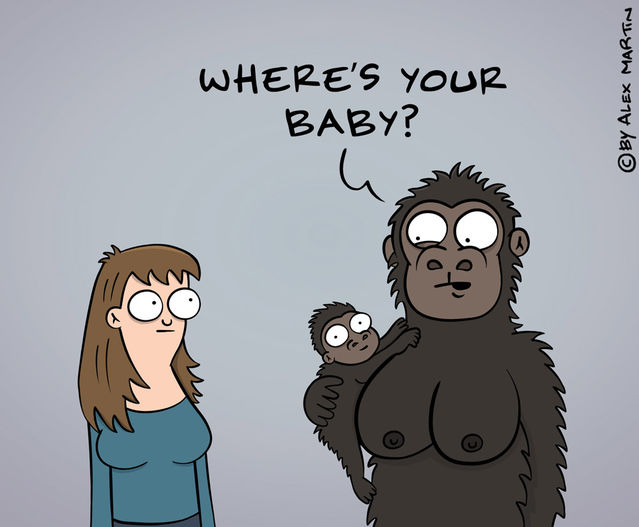
After completing my Ph.D. 50 years ago, I led an Oxford University expedition to Madagascar accompanied by four undergraduates. Occasionally, driving through remote areas in our Land Rover, we would surprise local lasses bathing with bare torsos. Seeing us pass, they would shyly cross their arms over their breasts. We quickly learned to wave vigorously, whereupon the lasses enthusiastically waved back. To our delight, friendliness trumped modesty.
Breasts are surely attractive for men, especially young adults from cultures in which women are taught to keep their breasts covered. Raised in this way, prudes often react indignantly to seeing a woman breastfeeding in public. Cultures that expect women to be fully clothed accentuate ambiguity about breasts as motherly milk sources or sexual signals. So it is crucial for evolutionary ideas about the functions of breasts to be tested across cultures. Most of the many studies on the attractiveness of breasts have addressed white-skinned people—mostly undergraduates—in industrialized populations.
The natural history of breasts
Nozzle-like teats supplied by ducts from milk glands, common to all female marsupials and placentals, are all that is needed for suckling. The mammal norm is nipple-feeding, not breast-feeding. Even when rearing babies, most show little swelling because it is not essential for milk production or suckling. Women’s permanently swollen globular breasts are a striking rarity. In a few mammals, notably elephants, breasts do swell in late pregnancy to prepare for suckling but generally deflate after weaning. The chest also remains flat until the first pregnancy in nonhuman primates, but breasts may be visibly swollen throughout suckling, especially in great apes. Sometimes, breasts stay swollen between pregnancies in older females that have reared several infants.
Another seemingly unique feature of the human breast is the areola—a conspicuous dark area of skin surrounding the nipple. The teat bears a circular array of 15-20 duct openings that release milk during suckling, while the areola bears the main physical impact. Depending on general skin pigmentation, the areola’s basic color varies from light pink to dark brown. In any individual woman, it also varies in response to hormonal changes across menstrual cycles, pregnancy, and aging.
Even compared to great apes, human breasts have two other notable features: first, initiation of permanent breast swellings is the earliest obvious change in a girl at puberty, several years before she first suckles an infant. Second, no other mammal has such big breasts compared to body size.
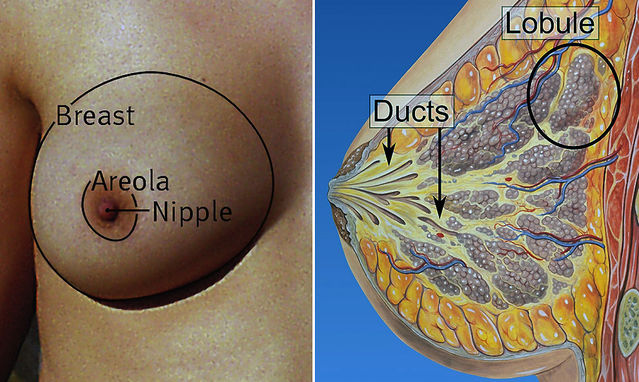
Explaining swollen breasts
Why does a woman have bulging breasts? Once developed, they have a core of typical mammalian milk-producing glandular tissue surrounded by copious fat deposits. This dual composition is clearly evident during puberty when both milk glands and accumulated fat expand in tandem. So a logical starting point for explaining breast size is the reasonable expectation that bigger breasts produce more milk.
In fact, milk is not exclusively or even mainly derived from fat deposits in the breasts. A woman suckling an infant needs to mobilize fat reserves throughout her body, not just from the breasts. Although women do have notably large breasts compared to other mammals, on average both together contain less than 4% of total body fat. Moreover, uniquely among mammals, the sexes differ distinctly: Women carry considerably more fat, concentrated at particular sites such as buttocks and thighs.
A 2018 paper by Herman Pontzer reviewing information on hunter-gatherers provided detailed information on body composition for the Hadza of Tanzania. In adults between 20 and 80 years old, fat constitutes 25% of body weight for women but only 10% for men. The body of an average healthy 100-pound Hadza woman hence contains some 25 pounds of fat, of which less than a pound would typically be contained in both breasts combined (outside pregnancy or suckling).
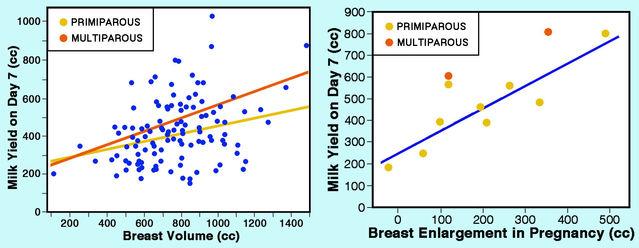
Do bigger breasts produce more milk?
It has long been known that a woman’s milk yield is not closely linked to breast size. In a much-cited 1954 paper, Frank Hytten reported results from a well-designed study of human breast size in relation to suckling. Data collected from over a hundred Scottish women a week after birth initially seemed to indicate a weak but significant association between breast size and milk output. However, for eleven women Hytten also measured breast size during the third month of pregnancy to calculate the amount of breast enlargement that occurred by day seven after birth. The extent of enlargement showed no connection with starting breast size, which varied widely between women, but was tightly correlated with milk output. This makes sense because in non-pregnant, non-suckling women milk glands account for a highly variable proportion of breast size, whereas breast size increase during pregnancy primarily reflects added glandular tissue.
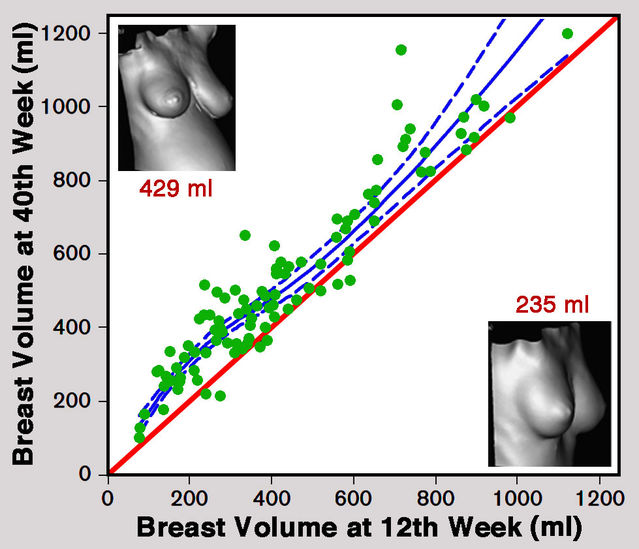
Regrettably, there has been little follow-up to Hytten’s study. But a 2014 paper by Christian Bayer and colleagues did provide valuable complementary evidence. Breast volumes were assessed for a hundred women at two stages of pregnancy, first during week 12 and again in week 40, just before birth. Between those two stages, the average volume of a single breast increased from 420 ml (14 fluid ounces) to 515 ml (171/2 fluid ounces). But, as in Hytten’s report, increases in breast size varied widely regardless of the initial volume.
Breast size variation
Crucially, average breast size varies greatly within and between human populations. Among other things, this is important for surgeons when reconstructing breasts after tissue removal or cosmetically modifying breast size. It is also of concern to clothing manufacturers, especially when engaged internationally.
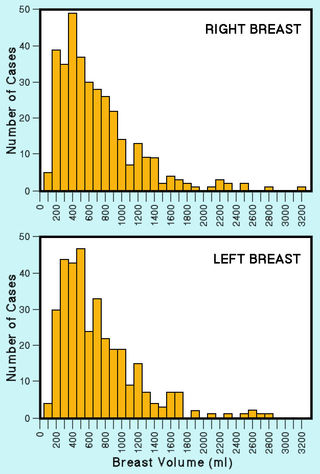
Remarkably, baseline data on the variation of breast size in women have rarely been compiled. One notable exception is a 2017 paper by Celeste Coltman and colleagues, who measured left and right breast volumes of 356 Australian women aged 18 to 84 years. Variation was substantial, extending from 48 ml (11/2 fluid ounces) to 3100 ml (61/2 pints). For left or right breasts (usually similar in size), the peak value was around 400 ml (less than a pint). Interestingly, breast volumes did not show a bell-curve distribution around an average value but were distinctly right-skewed. This pattern—also seen with other datasets—must be borne in mind when proposing that natural selection favors an optimal size.
In addition to the wide variation in breast sizes within a population, average values also differ substantially between populations. But well-documented data are scarce. The only widely-cited source is a 2013 paper by John Anderson and colleagues in a defunct journal. That paper indicates that women in Africa and Asia typically have relatively small breasts, contrasting with women in Europe, South America and, especially, North America. Any proposed evolutionary explanation should address this reported marked variation in average breast size between populations.
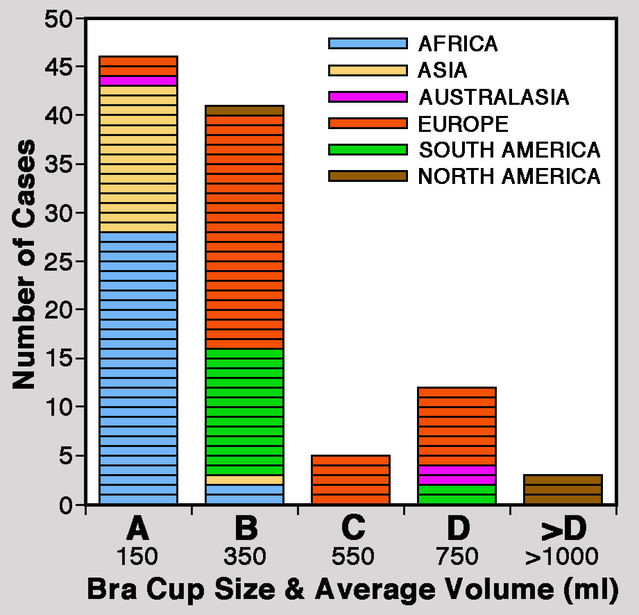
Breasts as visual magnets
Permanent swelling of the human breast from puberty onwards is not needed for milk production or suckling, so it presumably serves some other function. In 1987, in an article mischievously entitled "Human breasts, unsupported hypotheses reviewed," Tim Caro listed eight alternative explanations for the evolution of permanently swollen breasts. Thirty years later, a convincing interpretation remains elusive. Yet one point is clear: breasts definitely attract attention.
In two papers in 2010 and 2011, Barnaby Dixson and colleagues reported using an eye-tracking device to detect where, when and how long a man’s gaze rests when viewing a woman’s body. They tested three dozen men of European extraction with various front-posed female images, all derived from the same initial photograph of a naked woman but computer-morphed to vary breast size (small, medium, large). Almost half the men tested looked at the woman’s breasts first, taking less than a fifth of a second to do so, while a third began with the waist and one in seven with the pubic area or thighs. Only one in 16 men looked at the woman’s face first. Throughout the five-second tests, men looked at the breasts more frequently and for longer intervals.
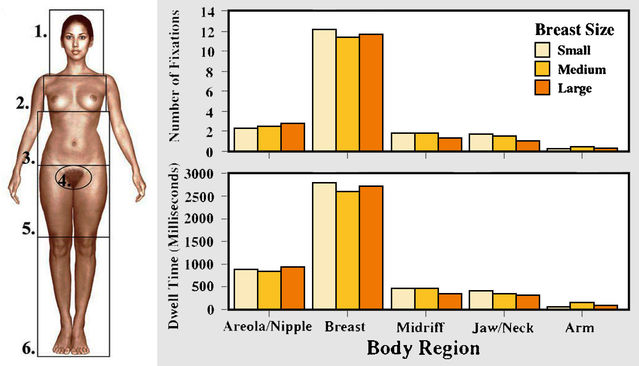
Taking things further
Much remains to be said about testing proposed explanations for swollen human breasts, but that requires a second blog post. For now, it can be concluded that human breasts do have several unique features, notably marked inflation from puberty. Regarding physical function, it seems clear that breast size before pregnancy is unimportant. What matters for milk production is breast enlargement during pregnancy. Breasts clearly attract men’s attention, but they do not reliably signal milk yield. An alternative explanation is needed, bearing in mind that any evolutionary inferences will be suspect without effective cross-cultural comparison.
Note: I am very grateful to Alan and Barnaby Dixson for permitting use of adapted figures from their fine papers, and to Alan for providing very helpful editorial comments.
References
Anderson, J.D.L., Chandler, S, C.L., Mason, M.A.B., Khan, C.B., Lindsay, J.E., Sandler, R.M. & Wong, L.G. (2013) Scientific analysis reveals major differences in the breast size of women in different countries. Journal of Female Health Sciences 13:268-292.
Anderson, P. (1983) The reproductive role of the human breast. Current Anthropology 24:25-45.
Bayer, C.M., Bani, M.R., Schneider, M., Dammer, U., Raabe, E., Haeberle, L., Faschingbauer, F., Schneeberger, S., Renner, S.P., Fischer, D., Schulz-Wendtland, R., Fasching, P.A., Beckmann, M.W. & Jud, S.M. (2014) Assessment of breast volume changes during human pregnancy using a three-dimensional surface assessment technique in the prospective CGATE study. European Journal of Cancer Prevention 23:151-157.
Caro, T.M. (1987) Human breasts, unsupported hypotheses reviewed. Human Evolution 2:271-282.
Coltman, C.E., Steele, J.R. & McGhee, D.E. (2017) Breast volume is affected by body mass index but not age. Ergonomics 60:1576-1585.
Dixson, B.J., Grimshaw, G.M., Linklater, W.L. & Dixson, A.F. (2010) Eye-tracking of men’s preferences for waist-to-hip ratio and breast size of women. Archives of Sexual Behavior 40:43-50.
Dixson, B.J., Grimshaw, G.M., Linklater, W.L. & Dixson, A.F. (2011) Eye tracking of men’s preferences for female breast size and areola pigmentation. Archives of Sexual Behavior 40:51-58.
Hytten, F.E. (1954) Clinical and chemical studies in human lactation. 6. The functional capacity of the breast. British Medical Journal 1(4867):912-915.
Katch, V.L., Campaigne, B., Freedson, P., Sady, S., Katch, F.I. & Behnke, A.R. (1980) Contribution of breast volume and weight to body fat distribution in females. American Journal of Physical Anthropology 53:93-100.
Marlowe, F. (1998) The nubility hypothesis: The human breast as an honest signal of residual reproductive value. Human Nature 9:263-271.
Mascia-Lees, F.E., Relethford, J.H. & Sorger, T. (1986) Evolutionary perspectives on permanent breast enlargement in human females. American Anthropologist 88:423-428.
Pontzer, H., Wood, B.M. & Raichlen, D.A. (2018) Hunter-gatherers as models in public health. Obesity Reviews 19 (Suppl. 1):24-35.




